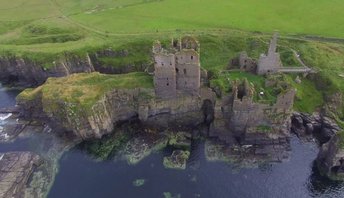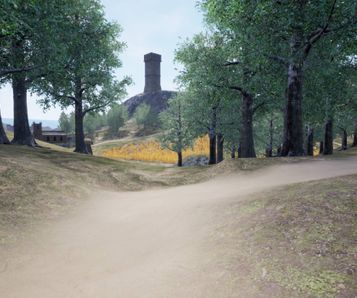Corilth
Open world design / world building
Summary
After an exhausting journey through the mountains, the player arrives in the land of Corilth. A lustrous land, filled with adventure and mysteries as well as deep seeded conflicts between rivaling factions and the Nobility presiding over the bustling Free City.
Goals
- To create a believable, large open world map.
- Create different areas tied to different factions.
- To make sure that the player always have a visible, interesting landmark to ease orientation.
Specification
- Individual project
- 6 weeks half-time
- Created using Unreal Engine 4
- Assets from Medieval docks, Meadow Environment set, Procedual Nature Pack, Brushify Medieval Buildings, Brushify terrain pack, (UE4 Marketplace) and myself (Autodesk Maya).
PRE-PRODUCTION
Inspiration
I started out by doing some research and gathering reference pictures around natural formation of landscapes in coastal- as well as mountainous areas.
I wanted to capture and create a believable landmass for the player to explore, so the layout and design had to be grounded in something that felt real.
IDEATION PHASE
The first sketch was focused on a compact, much smaller landmass with some basic gameplay implemented.
As this didn't really correspond to what I was after, I went back to the drawing board and created a landmass situated along the ocean as I felt that the first sketch lacked a meaningful* datum.
FINALIZING THE SKETCH
The second sketch felt much better.
The world had a much more genuine connection the the ocean and the villages and forts didn't feel out of place.
However the size of the map had increased a lot, which meant that I had to abandon the plan of implementing gameplay to the level/world since time was limited.
TERRAFORMING / BLOCKOUT
First brushstrokes
The gif below shows work done during the second week.
Although the first brushstrokes were rough and crude, I kept all landmarks I wanted to be observable from each location in mind.
Unexpected problems
I ran into some delays during terraforming as I wanted to try and experiment with new tools and features added to Unreal Engine. It was however, more difficult than I had originally anticipated to incorporate said tools into my already deformed terrain. So in lack of more hours dedicated to this piece, I decided to stick to the regular tools for the remainder of the project.
Overview finalization, world-map and detail-planning
When I had decided on a layout I liked, I started working on a world-map and a more definite plan for each of the different locations and areas.
(A simple world map created in photoshop)
DEFINING THE WORLD
Factions and Quest-areas
With the world-map serving as an overview, I started focusing on the specific areas and locations.
This is also when I defined which area was going to be populated by what faction, and set up bounds for quest-related areas to each location. (faction-/questmap below).
These have no actual impact on the level itself, but I wanted to create a framework for something that could be used when populating the world in a later stage.
Each highlighted faction-/quest area could be filled with multiple quests suitable for the location.
For example: political / stealthy missions could be implemented in the city area, while the Tilum / Koric woods areas could be more focused on exploration / combat.
The players mental map
I wanted to create a world where the player didn't have to rely on a minimap or compass telling them where to go. Instead i tried to design each different area with at least one landmark always visible as to easier create a mental map and to help with orientation.
If I had more time, I would have liked to improve the visual quality of certain areas as they feel a bit void.
Soft- and hard reveals
I used both soft and hard reveals as a technique to present/introduce certain areas.
For example; here is the soft reveal along the main path towards the Free City through Tilum Forest.
The player have a clear, framed landmark to focus on (watchtower).
As they reach the edge of the forest, the previously limited view opens up in front of the player, inviting them to the new area.
In Ceols Hollow I instead used a hard reveal to present an area for the player.
Following a narrow cave-passage, a sudden turn reveals a part of the settlement situated below ground.
THE FREE CITY OF CORILTH
Designing a massive city
My original idea was to design my own, vibrant large city. But due to time constraints, I decided to take an already existing city and make a quick blockout of it for the level / world.
Consisting only of basic shapes, it serves more as a concept of a large city rather than a finished area.
The city that I decided would fit the world best was Novigrad from The Witcher III: Wild Hunt.
The Free City is entirely based on Novigrad from the Witcher III: Wild Hunt with some minor adjustments.
Process
The city was a work in progress during the whole project. As I kept iterating on the landscape, I also had to mind the impact it would have on the city since I didn't want to obscure the vistas and views I had planned.
This resulted in me having to revisit the city for minor tweaks (elevations, building locations etc.) during the whole process.
Free City outskirts and the surrounding area
A large, booming city requires a lot of sustenance. A whole lot comes from trade such as fishing or game with nearby settlements, but also from the grain farmed outside the city.
I spent some time iterating on the areas outside the city. It was difficult to get the right feel of the area and not let it become a chore to traverse. My first plan was to only add some farmsteads to the area, but it felt empty and lifeless. With the addition of more buildings, windmills and an abandoned church the area came more to life and offered some improvements to the views and scenery.
WORLD LOCATIONS
The village of Sallum:
I wanted each area to have a connection to the world and to portray a clear genius loci.
Sallum for example is a fishing village situated on the shores of southern Corilth. To convey the importance of water for the inhabitants I designed a stilt-village inspired by similar architectures found in Africa and Asia.
Sallum is the first settlement the player will encounter on their way into Corilth following the mountain pass from the southern part of the map.
The village also introduces the player to the possibility of sea-faring. Both as means of fast-travel and exploration.
The flooded ruins of Icleod
Icleod was once a prosperous manor with a large portion of land under it's rule. After an especially cold winter, the melt-water from the mountains overflowed the river and flooded the whole area, carving out a new path for the water into the ocean.
The manor was abandoned due to major damages to it's structures and is now slowly sinking into the newly formed swamp.
Half a century after the disaster, a huge battle took place in the area as the Corilthian army fended off an invasion from raiding pirates. The rotting remains of war-machines can still be found in the area which is now both home and hunting grounds for bandits and fortune seekers.
The Priory of Penitence
About two centuries ago, the ruling nobility in the Free City separated the Octillium church from state.
This was a severe blow to the church and the separation led to mistrust against all practice of religion in Corilth. More or less forced to move their practices out of the city walls, the Octillium started the construction of a priory in the Koric Highlands.
The nobility approved the construction as Koric is sparsely populated, and they deemed the priory no threat to Corilthian affairs.
The priory has become a small sanctuary for religious practitioners of the Octillium and serves as another quest-area hub the player can visit. The High priests of the Octillium seek to once again be part of Corilthian politics and to regain their place of power in the land.
The priory have recently begun having problem with raiders and bandits coming from the old fort in the north to pillage and rob.
Far to the north, in a bay lies a mysterious island. Seemingly always shrouded in a thick mist, the Corilthians refer to the island simply as 'The Island of mists".
Few people know how to safely reach it's shores, and even fewer tries, knowing that those who venture to the island seldom returns.
Scattered throughout Corilth the player will encounter old monoliths whom seem to have a connection to the mysterious island but no one seem to know just how they are connected.
The Island of mists
Closing Thoughts
I'm really glad that I chose to go with a large, open world map, rather than a smaller one even though I never got to implement any gameplay.
I enjoyed the process of making one of my maps come to life as I had planned it.
Some areas feel a bit void and barren, but with more time I reckon that I could have improved the visual quality to easier convey the picture I was after.
Before making this level playable some more iterations will be needed. Performance is heavily impacted due to the use of one massive terrain instead of smaller, individual pieces stitched together.
Even though frustum-culling was taken into consideration in multiple areas, the map needs more work in order to optimise and improve performance.
Whats next?
I would like to take this project a bit further in the near future.
Initially I wanted to create a dungeon below the Ruins of Icleod as the area is rather empty right now, but within my timeframe, there simply wasn't enough time.
I would also like to implement a fast-travel system, and some kind of mount (horse) to speed up travel across the map. I did prepare areas with a simple sign-post that could serve as a fast-travel point, but without functionality.
Since I started working on a quest-system for an earlier assignment it would be fun to implement it in the future.
Thank you for stopping by,
and farewell.
Back to projects
Next portfolio project





































